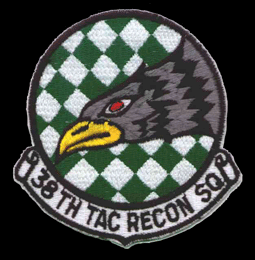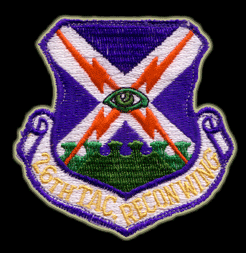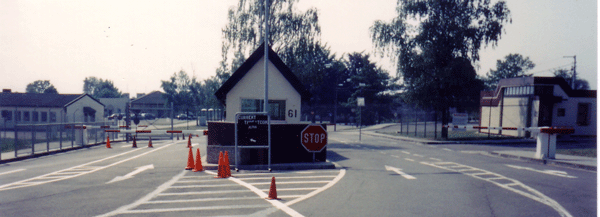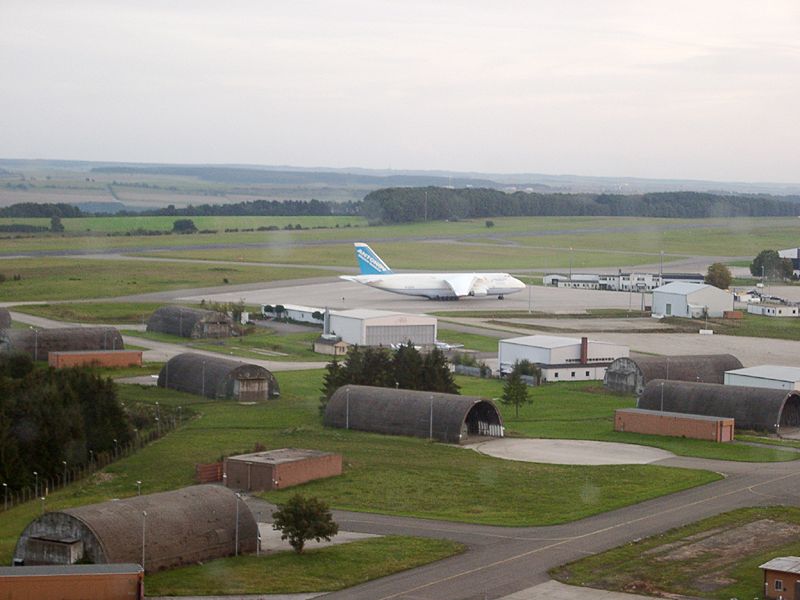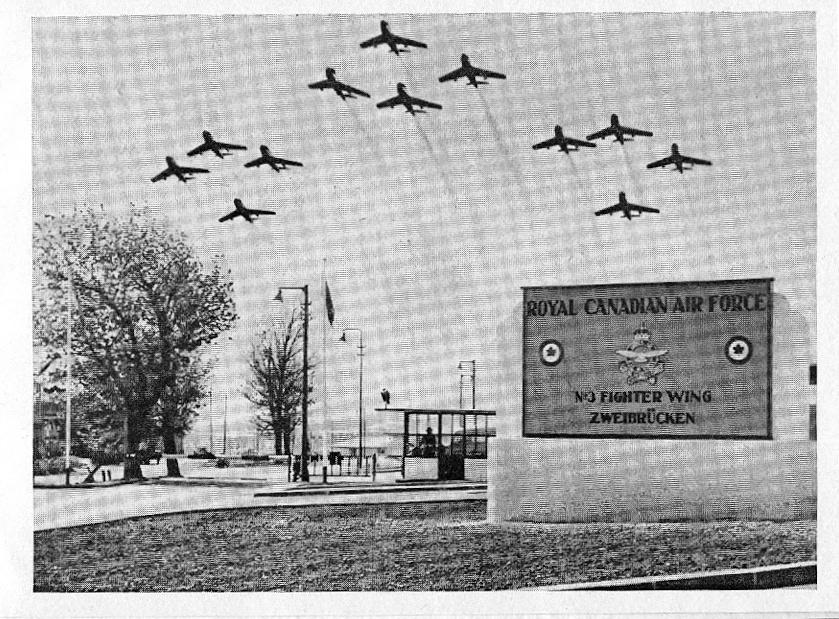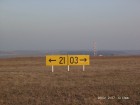History of Zweibrucken Air Base
Zweibrucken Air Base, Germany was the home of the 26th TRW before its closure in 1991. The base was located approximately two miles east of the city of Zweibrucken, on land that in 1938 was part of the Wermacht's (Nazi German Army) Siegfried Line. The crumpled remains of many of the bunkers of the old line are still in evidence on where the base used to stand, even today. After WWII, the Zweibrucken area was part of the French occupation zone. In 1950, at the request of the Canadian Government, the French approved construction of the air base. It was designed by French engineers and completed by German contractors in late 1952. Family housing was not built on the base itself; instead it was constructed near the city of Zweibrucken.
On 6 January 1953, the 3rd Wing, Royal Canadian Air Force (RCAF), commanded by Group Captain A.C. Hull, arrived to assume control of Zweibrucken Air Base. The 3rd wing operated the base for over 16 years. During this time, the Canadian Forces established excellent relations with the local German community through their ice hockey team, the RCAF Flyers.
The 3rd Wing and it's CF-104 Starfighters departed Zweibrucken in August 1969. Before leaving, they erected a west coast indian totem pole as a token of their friendship with the local German citizens. At the top of the pole was the Thunderbird, the god who watches over all creation. Below it was adouble headed sea monster, the warrior's symbol; the third figure was of a little man who had grown from boyhood to become a warrior, and the fourth figure was that of the same warrior, grown to maturity as a tribal chief.
At the time the base closed in 1991, the only visible reminders of the 3rd Wing RCAF was the totem, the stained glass windows of the Protestant Chapel, and the Peter Cunningham Memorial Arena.
Wtih the departure ot the Canadians, Zweibrucken AB was transferred to the control of the 17th Air Force and the United States Air Forces in Europe (USAFE). Because the base was a NATO installation, the US acquired it at no cost; however, since no Canadian-American purchase agreement was made, all non-NATO facilities and equipment were either removed or destroyed.
The 86th TFW was activated at Zweibrucken AB on 1 November 1969. It received its first flying unit, the 17th TRS, on 12 January 1970. The 17th TRS and its RF-4Cs came to Zweibrucken from the 66th TRW, Upper Heyford, United Kingdom
.
For 18 months the 17th was the only operational squadron on the base. On 12 June 1971, the 81st TFS was transferred to Zweibrucken. The 81st, with it's F-4C "Wild Weasel" fighters had previously been stationed at Hahn AB, Germany. on 31 January 1973, the 26th TRW at Ramstein was transferred to Zweibrucken AB and the 86th TFW was transferred to Ramstein.
On 9 November 1983, Headquarters Military Airlift Command (MAC) activated Zwei's second flying unit, the 10th MAS. Assigned to MAC, the squadron conducted it's flying operations utilizing the C-23A "Sherpa"
In the fall of 1988, HQ USAFE began planning to move two more units to Zwei and increase the support mission of the 26th TRW.. HQ USAFE planned to move the 601st Tactical Control Squadron (TCS) and the 612th Tactical Control Flight (TCF) from Prum Air Station, Germany to Zwei. The mission of the 601st and the 612th was to provide a line of radar detection systems wherever USAFE or NATO needed them. The two units arrived in June 1989, increasing the number of associate units on the base and diversifying the mission even more.
Reduction in force trends and the fall of the Soviet Union led to the downsizing of USAFE and the closure of many US airbases in Germany, including "Sunny Zwei". in 1991.
Today, Zweibrucken AB is a private industrial park and airport open to private businesses and zoned by the German government. Most of the buildings such as the TabVees are still standing and are being used for purposes ranging from storage to industry.
History of the 26th Tactical Reconnaissance Wing
Reprinted from undated informational pamphlet
Lieutenant Colonel Elliot Roosevelt commanded the 5th Photo Group at that time. When the group set up it's headquarters at La Marsa, Tunisia, on 8 September, the allies were just beginning the campaign against Italy. Since the pilots arrived early and they began flying missions with Roosevelt's Northeast African Photo Wing, almost immediately, primarily using F-5s to get pictures required for the aerial war against the Axis powers. The F-5 was an improved version of the P-38. The group not only flew the F-5s, but many other photographic-reconnaissance aircraft being tried out by the Army Air Force (AAF). Some of the aircraft included the F-7, F-9, and F-10. The F-7 was a modified Consolidated B-24J, while the F-9 was a modified Boeing B-17F and the F-10 was a modified North American B-25D. These aircraft were actually modified bombers that were lightly armed, and equipped with cameras and larger fuel tanks that allowed them to reach out beyond the range of the P-38s. These aircraft often brought up the rear on the bombing missions over Italy and the Balkans photographing the initial bomb damage to the targets.
Life in a photographic reconnaissance unit was less glamorous than in a fighter or even bomber unit. The reconnaissance pilot was except, perhaps, in some rare instances- neither an ace nor a potential ace; there were no swastikas painted on the fuselages of the group's aircraft. Nor did the pilots come back with stories of targets destroyed or aircraft shot down. Nevertheless, life was not dull. Flying deep into enemy territory, the "recce" pilot was acutely aware that should he encounter enemy fighters he would have to avoid the threat and then get home. Like daylight bombing, the use of unarmed reconnaissance planes was a calculated risk of the leaders of the AAF. General Henry H. "Hap" Arnold, Commanding General of the AAF, reasoned that if reconnaissance aircraft were armed, their pilots could not be restrained from giving battle when the enemy was encountered. This would have been detrimental to the war effort because it was vital that the intelligence gathered by the reconnaissance aircraft not be delayed in getting to the commanders of the ground and bomber forces who needed the information for mission planning.
Initially, the 5th flew its recce missions to Italy, Corsica and Sardinia, but as the fighting progressed towards the heart of the European continent, the operations area expanded. On 30 October 1943, the 5th flew its first mission to Germany, photographing targets in Munich, Augsburg, Regensburg and Stuttgart. In October 1943, allied forces successfully landed troops in southern Italy. As the war moved closer to the heart of the Axis, so did the 5th. On 22 November 1943, the 5th Group was assigned to the 90th Photographic Reconnaissance Wing, which was part of the 12th, AF stationed in southern Italy. On 8 December 1943, after the allies captured the airfields in the vicinity of Foggia, the group moved to San Severo, Italy, near Foggia.
The structure of the 5th Group changed several times during the following year. The 23rd Squadron was attached to and under the operational control of another group during two periods, from 9 February to 9 March and again from 23 August to 15 November 1944. On 21 January 1944, the 15th Combat Mapping Squadron was assigned to the group. The 15th had F-9s and F-10s which were used for night photographic missions until June 1944 when they were transferred away from the group. Before the departure of the 15th, the group gained the 32nd Photographic Reconnaissance Squadron (on 30 April 1944). The convoy carrying the 32nd Squadron was attacked by German submarines however; the ship carrying the pilots and enlisted men was torpedoed and sank with the loss of everyone on board. The other ship carrying 25 of the squadron's ground officers arrived safely, and these became the nucleus of the squadron. The squadron was brought up to strength with the transfer of men from other units, but it was not until 15 November 1944, before the 32nd could fly any missions. When the 32nd regained its strength, they gained many different aircraft. Since many of it's pilots came from different reconnaissance units throughout the the American Air Forces in Europe, they brought their aircraft with them. This gave the squadron a mixture of aircraft able to fly different photo missions. The most interesting aircraft the 32nd flew at this time was the F-8, a British aircraft known as the "Mosquito" but it held an AAF designation. The F-8 was a DeHavilland B. Mk XX, a twin engine fighter-bomber.
Beginning in November 1944, the 5th Photo group flew its mixed bag of aircraft all over the European Theatre of Operations. The 5th photographed many strategic targets in Germany including: oil refineries, aircraft factories, and communication facilities. Their destruction helped reduce the strength of the Luftwaffe. In the mountain campaign of Northern Italy, the 5th gathered intelligence which helped allied forces break the hold of the German Army in Italy. In Eastern Europe, the 5th's reconnaissance reports resisted partisan and other Allied forces to push the Germans out of Austria, Czechoslovakia, and the Balkans. By May 1945 the photo missions were over and so was the war.
After the end of the fighting in Europe, the group's historical officer made the following summary of the group's activities:
"The 5th reconnaissance Group was able to look back upon it's overseas period and find satisfaction in a task well done. From the time the group began operating against the enemy in September 1943, to the day of the German surrender, the 15th, 23rd, 32nd and 37th Squadrons obtained photographic coverage of targets in an enormous expanse of Europe. All of Italy, the Balkans from the southern tip of Greece northward up into Poland, Austria, Germany as far north as Berlin, and half of France all furnished (photographable) material for the pilots, the photographic laboratory personnel, the interpreters, and the topographic engineers working with the group. Industry, communications, defenses, supply dumps, airfields, radar equipment, shipping all of these that had once been the enemy's were watched during the months. The mass of intelligence material obtained by the group has been used by the allied air, sea and ground forces alike. In recent months, working primarily for the 15 AF, the 5th Reconnaissance Group has furnished pre-raid and bomb damage assessment information, prepared thousands of reports and charts of the enemy's installations and movements and, in general, made itself of service as the eyes of the Air Force."
In August 1945, the group was notified that it was scheduled for shipment to the United States during September, but the departure was delayed until 9 October, when the men sailed from Naples aboard the SS NOAH WEBSTER. On 26 October 1945, the ship carrying the men of the 5th arrived at New York Harbor. Two days later, the group was inactivated at Camp Kilmer, New Jersey. Two years later, on 6 March 1947, the non-operational and unmanned 5th was disbanded.
The history of the 26th Strategic Reconnaissance Wing, medium (26 SRW) began on 28 May 1952, when it was activated by Headquarters, USAF. The 26 SRW was created as a means to gather intelligence before a war began. The 1950's was the time known as the "Cold War," a period where the US and the Soviet Union sparred with each other on a global scale. From this era came a need for better, faster-flying, longer ranged reconnaissance aircraft, and a need to gather intelligence on a global scale, for the strategic objective of the US. From that need, the strategic reconnaissance force of the Strategic Air Command (SAC) was born. When it was activated, HQ SAC decided to station the 26th at Lockbourne AFB, Ohio. Assigned to SAC's 801st Air Division, the 26 SRW flew day and night strategic reconnaissance missions. From it's home at Lockbourne AFB, the 26 SRW not only flew operational reconnaissance, but developed the capabilities of the Boeing YRB-47 "Stratojet"
With the exception of the 26th Air refueling squadron, Medium, the wing and its squadrons were manned with only minimal strength. In 1953, the flying squadrons began receiving additional personnel. The flying squadrons were the 3rd, 4th and 10th Strategic Reconnaissance Squadrons, Medium. In July 1953, the wing began transitional training in YRB-47s. In March of that same year, the RB47Es began to replace the YRB models. By the end of December 1954, the wing's last two YRB-47s were sent to Dobbins AFB, Georgia, for modification. In February 1955, these two aircraft were returned to the wing as RB-47B-1s. By the following year, the wing was only flying RB-47Es. The 26 SRW's other aircraft, the Boeing KC-97Fs and later KC-97Gs were flown by the 26th and 321st Air Refueling Squadrons, Medium. These units were assigned to the wing in May 1952 and April 1955, and remained as part of the wing until September 1956 and April 1958, respectively.
The wing participated in a variety of SAC directed exercises and operations between 1953 and 1958. These included numerous simulated combat missions and deployments, ranging from a few days to a few months. The exercises took the wing's reconnaissance and tanker aircraft to such bases as Eielson AFB, Alaska; Thule AFB, Greenland; Royal Air Force stations at Upper Heyford and Fairford, United Kingdom; Sidi Slimane in Morocco; Goose Bay, Laborador; and Lajes Field in the Azores.
In December 1957, the wing learned that it was to be inactivated the following summer. On 15 April 1958, the 321st Air Refueling Squadron was reassigned to the 301st Bombardment Wing, as were the remainder of the wing's aircrews. The wing's strength was slowly reduced by transferring personnel to other units. On 1 July 1958, the 26th Strategic Reconnaissance Wing was inactivated.
On 19 April 1965, the 26th Strategic Reconnaissance Wing was consolidated wit the earlier 5th Reconnaissance group, redesignated the 26th TRW, activated, and assigned to USAFE. On 1 July 1965, the wing was organized at Toul-Rosieres AB, France, and assigned to 3rd AF. Two months later, on 1 September 1965, it was reassigned to 17 AF.
Two months later, on 1 December 1965, the 22 TRS was organized and assigned to the wing. The squadron had no aircraft upon organization, but spent its first month preparing for the arrival of it's first RF-4Cs in January 1966. The 38 TRS, based at Ramstein AB, Germany, was assigned to the wing on 1 January 1966. In turn, the 32 TRS was transferred to the 10 TRW at RAF Alconbury, United Kingdom, however, its personnel and aircraft deployed to Southeast Asia as the 12 TRS.
In August 1966, the 32 TRS was reassigned to Southeast Asia, followed in September by the 22 TRS. This left the wing with only the 38 TRS at Ramstein AB, Germany. Subsequently, with the French Government's decision to withdraw from NATO and it's demand for the removal of all NATO forces from French soil, the 26 TRW was moved to Ramstein. By 5 October 1966, when the wing established itself at Ramstein, the 38 TRS was in the final phases of converting to the RF-4C. At Ramstein, the wing was also responsible for operating and administrating the base, a task formerly performed by the 7030th Combat Support Wing.
The 26 TRW while at Ramstein AB acquired a number of other units with different flying missions. One function gained by the 26 TRW, almost immediately after arriving at Ramstein, was the maintenance and flying of the HQ USAFE liaison aircraft. The wing was responsible for flying members of the HQ USAFE staff to Air Force and NATO bases throughout Europe. The unit was only designated a flight, because of it's small size. It consisted of a mixture of aircraft, including: T-29s, T-33s, T-39s, C-54s, O-2s, H-19s, and UH-1s. The 526th Fighter Interceptor Squadron (FIS), flying F-102 aircraft, was assigned to the wing in November 1968, thus adding an air defense role to the mission of the wing. The 526 FIS was redesignated the 526th Tactical Fighter Squadron (TFS) on 1 April 1970 and begun converting to the F-4E fighter aircraft. In the spring of 1972, the 7th Special Operations Squadron (SOS) was assigned flying C-130Es, C-47As, and UH-1Ns. Because of the special operations mission of the 7 SOS, it reported directly to HQ USAFE for operational control.
As part of CREEK ACTION, a command-wide effort to realign functions and streamline operations, USAFE transferred the 26 TRW from Ramstein to Zweibrucken AB, Germany, and the 86th Tactical Fighter Wing (TFW) from Zweibrucken to Ramstein on 31 January 1973. These moves were made without the transfer of personnel or equipment with the exception of the 38 TRS, 7 SOS and 81 TFS. The 38th remained under the control of the 26 TRW by moving to Zweibrucken with the wing and the 7 SOS transferred to Rhein-Main AB. The 81 TFS transferred from Zweibrucken to Spangdahlem AB, Germany. When the wing moved to Zweibrucken, the 17 TRS stayed there to become part of the 26 TRW. The 17 TRS had been stationed at Zweibrucken since January 1970. The 526 TFS remained at Ramstein AB, and it was reassigned to the 86th Tactical Fighter Wing.
For nearly five years the wing remained stable at Zweibrucken. Then on 1 October 1978, the 417th Tactical Fighter Squadron was activated and assigned to the 26 TRW. USAFE planned on equipping the squadron with F-4Es, however, inadequate munitions storage compelled the command to reverse its decision and consequently inactivated the 417th On 1 November 1978. Later that month, on 20 November, the 17 TRS was inactivated leaving the 38 TRS as the wing's only in-place operational squadron.
On 9 November 1983, the Military Airlift Command (MAC) activated the 10th Military Airlift Squadron (MAS). The 10 MAS flew the c-23 "Sherpa", a small cargo plane that needed only a little bit of runway and less fuel than larger cargo aircraft. The 10 MAS though under the direction of the 322nd Air Division (MAC) at Rhein-Main AB, became an associated unit of the 26th drawing support from it. The 26 TRW provided the 10 MAS all of its facilities and logistical support required to operate the European Distribution System (EDS). The EDS was organized to give the units in Europe a quicker way to receive small equipment items or supplies on a round-the-clock basis, without the expense of the larger cargo aircraft.
In 1985, another role was added to the wing's mission. On 15 October 1984, the 609th Contingency Hospital was activated by HQ USAFE. The mission of the 609th was to provide a turnkey hospital operation, where the equipment, and supplies were already in place and all the organization needed was the people to operate it, when called upon.
On 10 August 1987, the 26 TRW became the only tactical reconnaissance wing in USAFE, when the 10 TRW at RAF Alconbury was redesignated the 10th Tactical Fighter Wing and assigned to fly A-10 attack aircraft. This left NATO and US Forces in Europe the services of just one US tactical reconnaissance unit and one squadron of RF-4Cs.
The wing continued to conduct reconnaissance operations in support of NATO, USAFE, and the US Army in Europe (USAREUR). The wing also engaged in operational employment and development of advanced reconnaissance systems to further enhance the military posture of NATO in Europe until the wings deactivation in 1991.
.
